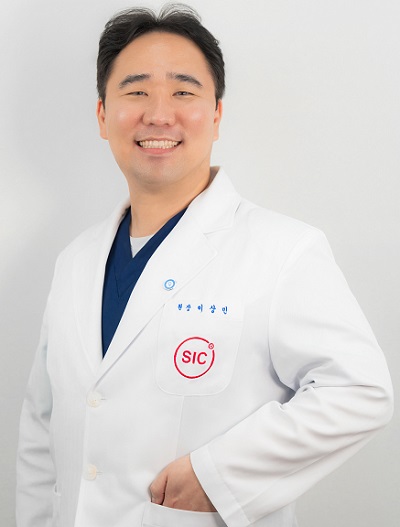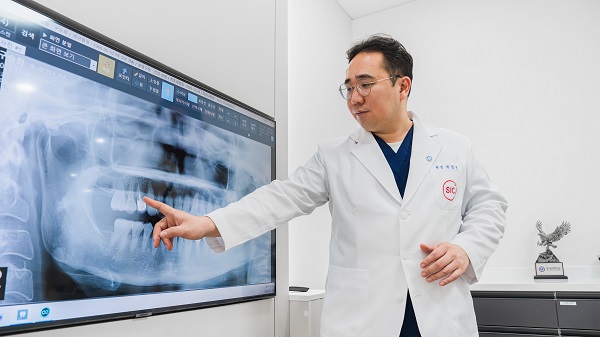Healthcare Dental Care South Korea hospital in Korea
Gangneung implant for foreingner
Digital Healthcare Dental Care

"Breathing the fresh air during my commute and the warm hospitality of the residents are truly heartwarming. Above all, being able to provide a pleasant surprise to patients who had to travel far and wide because there were no dental clinics offering implant surgery is truly satisfying."
Lee Sang-min, CEO of Gangneung Yeonhee Plant Dental Clinic, boldly left Seoul behind after a decade to establish a new practice in a regional area. He expressed no regrets about his decision, stating that he can now freely provide the essential treatments that local patients need.
What was the reason behind your decision to move to a regional area?
While practicing in the heart of Seoul was fulfilling in its own way, the unique characteristics of the Gangnam district meant that I was always busy attending to patients.
Additionally, as the number of patients increased, I found myself neglecting the medical volunteer work that I had always been passionate about. Of course, I could have contributed as an "angel hospital" in the healthcare trend's support for hidden patients, but I felt a void in my heart because I couldn't personally reach out to patients in underserved areas.
There are still many healthcare blind spots throughout South Korea. While public health doctors are deployed to health centers and sub-health centers, there is no place without a doctor, but there are limits to satisfying the high medical demands of regional patients.
Although transportation is relatively accessible in the Yeongseo region of Gangwon Province, Yeongdong has comparatively lower accessibility. In reality, patients from the Yeongseo region sometimes traveled to Seoul for treatment, but Yeongdong area patients couldn't do the same. I wanted to revitalize the Yeongdong region based on the clinical experience and expertise I had built up over the years.
What were the significant differences you noticed compared to Seoul?
There were three significant differences. First, I can now experience clean air during my daily commute, which I couldn't enjoy in Seoul. Regarding patient care, I've noticed many patients with poor oral health in the region.
Unlike Seoul, there are very few dental facilities in regional areas apart from emergency rooms or maternity facilities.
The cost of treatment is high, and there are limitations in the scope of services provided. The most common question I hear from patients is, "Is it possible to have implant surgery here?"
Furthermore, in Seoul, we had coordinators dedicated to explaining the treatment process to patients. However, regional areas need to be more aware of the need for dental services, even among patients.
Consequently, it has been challenging to hire staff for these roles. Patients also find this system unfamiliar and may sometimes exhibit impolite behavior at the front desk.
Nowadays, the government also evaluates healthcare facilities, focusing on patient satisfaction. Regional healthcare facilities need to make more efforts to approach patients from their perspective and meet their needs.

If you have any unique treatment systems in your dental practice, please introduce them.
In Seoul, we had the vision to provide specialized and faster dental care for patients, aiming for a better life for our patients, as reflected in the name of our hospital, "Good Life Dental Hospital."
To achieve this, we operated a comprehensive hospital system specializing in Integrated Dentistry, Prosthodontics, Periodontology, and Orthodontics departments.
However, coordinating and collaborating among specialists often led to longer appointment times for individual patients, resulting in an increase in waiting patients. Communication gaps among the medical team members also sometimes required repetitive explanations to patients.
Additionally, as rental costs in the regional area are lower than in Seoul, I could allocate more resources to equipment and interior design to create a comfortable environment.
On a personal note, I am currently an instructor at the Osstem Implant Training Center (OIC), which allows me access to the latest products and advancements in dental implantology.
I am committed to rigorous infection control and sterilization protocols to ensure the safety of implant materials for patients. In the future, I also plan to conduct infection control training through periodic seminars for local healthcare professionals.
Dental treatments are also becoming digitalized. Are there any challenges in the current regional setting?
Digital dental equipment can be broadly categorized into digital imaging, scanning, and milling. Most regional healthcare facilities have digital imaging equipment.
However, adopting scanning and milling equipment can be challenging, primarily due to its cost and the lack of personnel proficient in its operation.
Even if the equipment is acquired, setting up an in-house milling facility like in Seoul takes a lot of work. Finding external milling facilities is also quite challenging. The adoption of digital scanning equipment in dental practices is limited in the region, as the dental prosthetic industry does not show much interest.
After careful consideration, I collaborated with a dental prosthetic lab in Seoul, where I had worked for ten years. We send the digital scan data to their digital milling equipment, allowing them to produce high-quality dental prosthetics.
For digital medical devices related to dental implants, we rely on specialized companies like Osstem. Of course, we have basic milling equipment in-house for the final touches. In the future, I plan to collaborate with Yeongdong University and Osstem Implant to promote industry-academic cooperation, aiming to establish a comprehensive digital dental treatment system in Gangneung.

Has your initial treatment philosophy remained unchanged?
Many dental clinics emphasize rapid treatment as their strong point, but a long-term commitment is crucial when it comes to implants. Implants are not just about the surgery; post-surgical maintenance is equally, if not more, essential.
A doctor is not God. Rather than promoting the best or finest treatment, my focus is on at least "not harming the patient." This principle remains unchanged.
After experiencing the challenging healthcare environment in the region, I made a firm commitment to study even harder. I aim to proactively organize seminars and education to disseminate the latest knowledge to local healthcare professionals.
I also resolved to have a broader perspective considering a patient's entire life during treatment. As a dentist, I have the power to restore a patient's oral health, which can transform their life.
Through the Hidden Patient Support program, I've brought smiles to patients who couldn't smile before and instilled confidence to move forward in society.
Are you still committed to medical volunteer work?
Absolutely. I'm already in the process of preparing agreements with local welfare organizations. In particular, the hidden patient support program is something I take pride in, and I'm grateful that I can continue to work on it.
The reason I came here was to provide better healthcare to patients in medical blind spots. I want to provide the best possible dental care to those who need it, not only in the Clinic but also through home visits and shared medical services.


